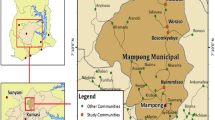Abstract
A number of pesticide residues in fruits were monitored at five markets in the Accra Metropolis for almost a year. Locally produced fruits (pawpaw and tomato) and imported apple were purchased from these selected markets in the metropolis and analyzed for pesticide residues by gas chromatography equipped with electron capture detector. In all, 320 sampled fruits were extracted and analyzed for pesticide residues, mainly organochlorines (γ-HCH, δ-HCH, aldrin, heptachlor, γ-chlordane, heptachlor epoxide, α-endosulfan, p,p′-DDE, endrin, β-endosulfan, o,p′-DDT, endrin aldehyde, p,p′- DDT, endrin ketone, and methoxychlor). The data revealed that 32.8% of the fruit samples analyzed contained residues of the monitored insecticides above the accepted maximum residue limit (MRL) whereas 48.7% were below the MRL. Nonetheless, the continuous consumption of such fruits with modest pesticide levels can accumulate and could result in deadly chronic effects.
Similar content being viewed by others
References
Adeyeye, A., & Osibanjo, O. (1999). Residues of organochlorine pesticides in fruits, vegetables and tubers form Nigeria markets. The Science of Total Environment, 231, 227–233.
Awumbila, B., & Bokuma, E. (1994). Survey of pesticides used in the control of ectoparasites of farm animals in Ghana. Tropical Animal Health and Production, 26(1), 7–12.
Barriada-Pereira, M., Gonzalez-Castro, M. J., Muniategue-Lorenzo, S., Lopez-Mahia, P., Prada-Rodriguez, D., & Fernandez-Fernandez, E. (2005). Organochlorine pesticide accumulation and degradation products in vegetation samples of a contamination area in Galicia (NW Spain). Chemosphere, 58, 1571–1578.
Bhanti, M., & Taneja, A. (2005). Contamination of vegetables of different seasons with organophosphorus pesticides and related health risk assessment in northern India. Chemosphere, 69, 63–68.
Bozongo, J. C., Donkor, A. K., Nartey, V. K., & Larceda, L. D. (2004). Mercury pollution in Ghana: A case study of environmental impacts of artisanal gold mining in sub-saharan Africa. In: L. D. de Larceda, R. E. Santelli, E. K. Duruursm, & J. J. Abrao (Eds.), Environmental geochemistry in tropical and subtropical environments (pp. 135–156). New York: Springer.
Darko, G., & Aquaah, S. O. (2006). Levels of organochlorine pesticides residues in meat. International Journal of Environmental Science and Technology, 4(4), 521–524.
Dinham, B. (1993). Growing vegetables in developing countries for local urban populations and export markets: Problems confronting small-scale producers. Pesticide Management and Science, 59, 575–582.
Fan, M. A., & Alexeeff, G. V. (1999). Public health goal for endrin in drinking water (pp. 5–6). Office of Environmental Health Hazard Assessment, California Environmental Protection Agency.
Fontcuberta, M., Arqués, J. F., Villalbí, J. R., Martínez, M., Centrich, F., Serrahima, E., et al. (2008). Chlorinated organic pesticides in marketed food: Barcelona, 2001–06. Science of the Total Environment, 389, 52–57.
FAO/WHO (1993). Food Standards Programme. Pesticide residues in food (Vol. 2). Codex Alimentarius.
FAO/WHO (1998). Joint FAO/WHO Food Standards Programme. Codex Alimentarius Commission. Pesticide residues in food-maximum residue levels (546 pp.). Rome: FAO Publishing Division.
Hardy, J. (1995). Apolipoprotein E in the genetics and epidemiology of Alzheimer’s diseases. American Journal of Medicine and Genetics, 60(5), 456–460.
International Programme on Chemical Safety (IPCS) (1992). Endrin Geneva, World Health Organization.
Krauthacker, B., Romanica, S. H., & Reiner, E. (2001). Polychlorinated biphenyls and organochlorine pesticides in vegetation samples collected in Croatia. Bulletin of Environmental Contamination and Toxicology, 66, 334–341.
Luke, M. A., Matsumoto, H. T., Cairns, T., & Hundley, H. K. (1988). Levels and incidence of pesticides residues in various foods analyzed by the Luke Multiresidue Methodology for fiscal years 1982–1986. J. Assoc. Off. Anal. Chem., 71, 415–433.
Ministry of Agriculture (1990). Ghana medium term agricultural development programme (MTADP): An agenda for sustainable agricultural growth and development.
Ministry of Public Health, Welfare and Sports (2007). Netherlands analytical methods of pesticide residues and foodstuffs. Netherlands.
Nakata, H., Kawozoe, M., Arizono, K., Abe, S., Kitano, T., Shimada, H., et al. (2002). Organochlorine pesticides and polychlorinated biphenyl residues in foodstuffs and human tissues in China: Status of contamination, historical trend and human dietary exposure. Achieves Environmental Contamination and Toxicology, 43, 473–480.
Ntow, W. J. (2001). Organochlorine pesticides in water, sediment, crops and human fluid in a farming community in Ghana. Archives of Environmental Contamination and Toxicology, 40(4), 557–563.
Ntow, W. J. (2005). Pesticide residues in Volta Lake, Ghana. Lakes and Reservoirs Manage, 10, 243–248.
Osafo, A. S., & Frempong, E. (1998). Lindane and endosulfan residues in water and fish in the Ashanti region of Ghana. Journal of Ghana Science Association, 1, 135–140.
Rajendran, B., & Subramanian, A. N. (1997). Chlorinated pesticide residues in water from River Kaveri, South India. Chemistry and Ecology, 13, 225–236.
WHO (1996). Health criteria and other supporting information. Guidelines for drinking-water quality (Vol. 2., 2nd ed.). Geneva: WHO.
WHO (2004). The WHO recommended classification on pesticides by hazard and guidelines to classification 2000–2002. Geneva: World Health Organization Programme on Chemical Safety.
Author information
Authors and Affiliations
Corresponding author
Rights and permissions
About this article
Cite this article
Bempah, C.K., Donkor, A.K. Pesticide residues in fruits at the market level in Accra Metropolis, Ghana, a preliminary study. Environ Monit Assess 175, 551–561 (2011). https://doi.org/10.1007/s10661-010-1550-0
Received:
Accepted:
Published:
Issue Date:
DOI: https://doi.org/10.1007/s10661-010-1550-0




